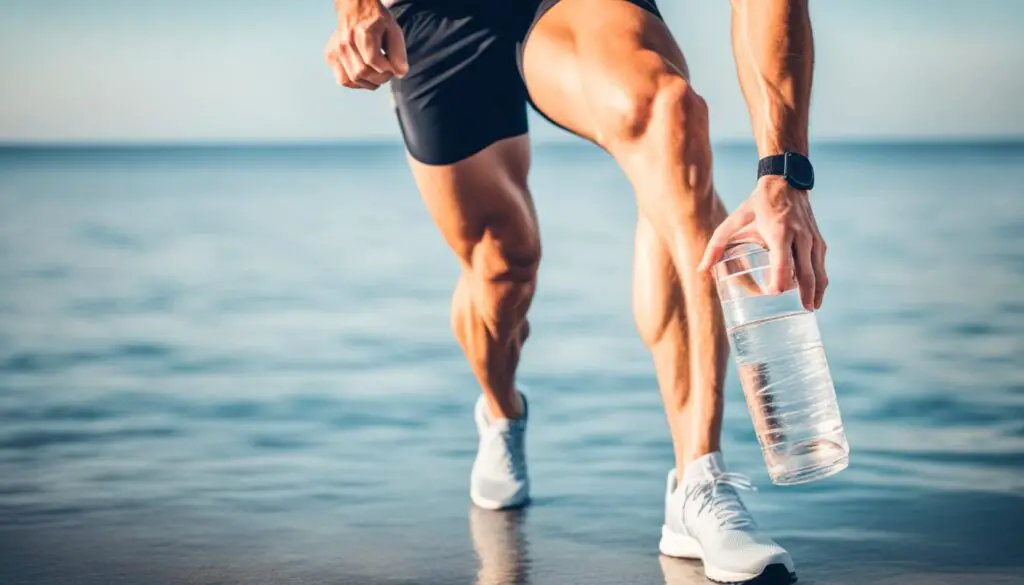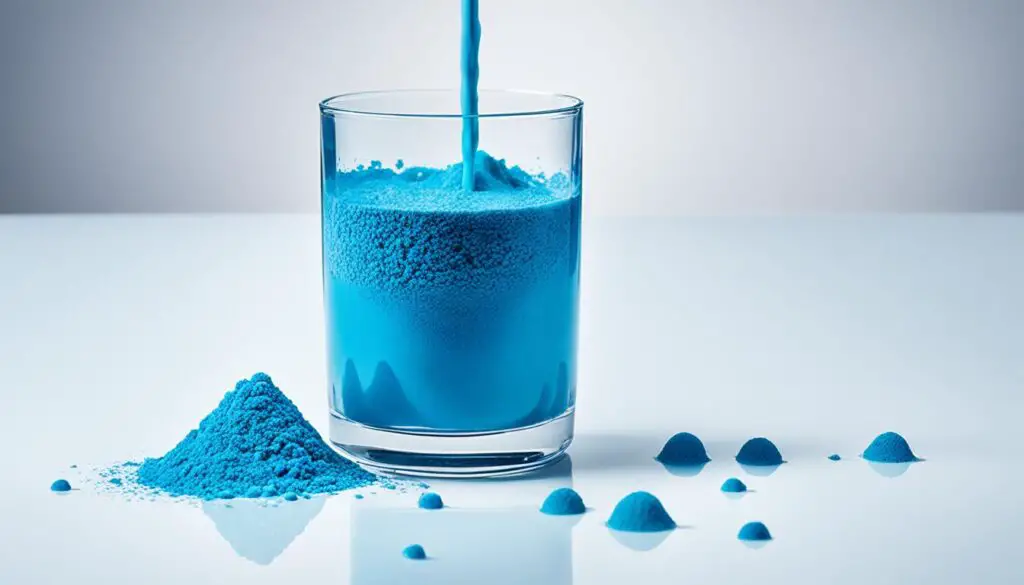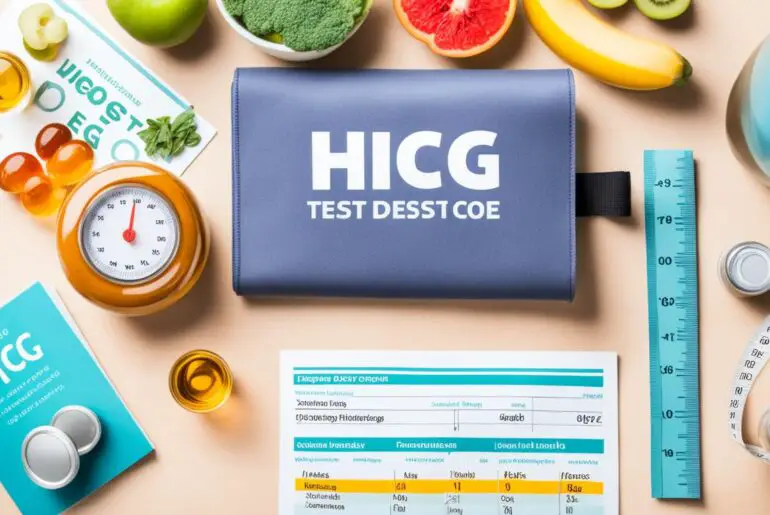Have you ever wondered why leg cramps can disrupt your sleep and hinder your progress on the HCG diet? It’s a common problem that many people face, but the good news is that there are effective remedies to provide relief and help you stay on track with your diet goals. In this article, we’ll explore the causes of leg cramps on the HCG diet and share valuable tips to alleviate the discomfort. Are you ready to discover how to overcome leg cramps and enhance your HCG diet journey? Let’s dive in!
Key Takeaways:
- Leg cramps are a common side effect of the HCG diet.
- Low-carb dieting can contribute to leg cramps.
- Taking a magnesium supplement can help relieve leg cramps.
- Increasing salt intake and consuming potassium-rich foods can prevent leg cramps.
- Staying hydrated and trying alternative remedies like yellow mustard or pickle juice can provide quick relief.
Why Are My Legs Cramping on the HCG Diet Plan?
Leg cramps on the HCG diet can be a result of low-carb dieting. While not everyone experiences this symptom, those who do may find it debilitating and may consider abandoning the diet. It’s important to understand the potential causes of leg cramps in order to find effective relief strategies.
Magnesium Supplement for Leg Cramp Relief
Taking a magnesium supplement is a commonly recommended remedy for leg cramps. Magnesium plays a crucial role in muscle function and helps relax contractions, making it an effective solution for relieving leg cramps. There are several ways to incorporate magnesium into your routine:
- Oral Supplementation: Taking a daily magnesium supplement can help prevent leg cramps. It’s important to start with a small dose and gradually increase it as needed. Consult with a healthcare professional to determine the appropriate dosage for you.
- Epsom Salt Bath: Soaking in an Epsom salt bath is another way to replenish magnesium levels and relieve muscle tension. Add about 2 cups of Epsom salt to warm bathwater and soak for 20-30 minutes.
- Mineral Water: Consuming mineral water that is high in magnesium can also provide relief from leg cramps. Look for brands that contain a significant amount of magnesium and incorporate them into your daily hydration routine.
The Benefits of Magnesium for Leg Cramps
When it comes to leg cramp relief, magnesium offers several benefits:
- Relaxes muscle contractions: Magnesium helps relax muscle fibers and relieves tension, reducing the frequency and intensity of leg cramps.
- Promotes better sleep: Leg cramps can often disrupt sleep. Magnesium supplementation can improve sleep quality by reducing nighttime leg cramps.
- Supports overall muscle health: Magnesium is essential for proper muscle function and plays a role in maintaining healthy muscle contraction and relaxation.
I highly recommend considering a magnesium supplement to alleviate leg cramps on the HCG diet. However, it’s important to consult with a healthcare professional to determine the right dosage and ensure it aligns with your individual needs and medical history.
| Magnesium-Rich Foods |
|---|
| Spinach |
| Almonds |
| Avocado |
| Mackerel |
| Pumpkin seeds |
Adding magnesium-rich foods to your diet can also contribute to optimal magnesium levels. Incorporate foods like spinach, almonds, avocado, mackerel, and pumpkin seeds to boost your magnesium intake naturally.
Increase Salt Intake to Prevent Leg Cramps

When following a calorie-restricted diet like the HCG diet, it’s common to consume less salt than the body is accustomed to. This reduction in salt intake can lead to an electrolyte imbalance, which can result in severe leg cramps. Fortunately, increasing salt intake within recommended limits can help prevent leg cramps and maintain proper electrolyte balance.
Electrolytes, such as sodium, play a crucial role in muscle function. Inadequate salt intake can disrupt the delicate balance of electrolytes in the body, leading to muscle spasms and cramps. By increasing salt intake, you can replenish the sodium levels and prevent leg cramps.
The Role of Salt in Leg Cramp Prevention
Salt, or sodium chloride, contains essential electrolytes that facilitate the transmission of nerve signals and maintain fluid balance in the body. When there is an imbalance of electrolytes, muscles, including those in the legs, can contract involuntarily, resulting in painful cramps.
By increasing salt intake, you provide your body with the necessary sodium to restore electrolyte balance. This can prevent muscle spasms and reduce the likelihood of experiencing leg cramps while on the HCG diet.
Recommended Salt Intake Limit
It’s important to note that while increasing salt intake can be beneficial for preventing leg cramps, it should be done within the recommended limits. The American Heart Association recommends consuming no more than 2,300 milligrams (mg) of sodium per day, which is equivalent to approximately one teaspoon of salt.
Exceeding the recommended salt intake can have negative health effects, such as increased blood pressure and water retention. Therefore, it is crucial to strike a balance and ensure you’re not consuming excessive amounts of salt.
| Type of Salt | Sodium Content |
|---|---|
| Table salt | 2,325 mg per teaspoon (5.8 grams) |
| Sea salt | 1,920 mg per teaspoon (5.8 grams) |
| Kosher salt | 1,520 mg per teaspoon (5.8 grams) |
| Pink Himalayan salt | 2,300 mg per teaspoon (5.8 grams) |
As you can see, different types of salt contain varying amounts of sodium. It’s important to read labels and be aware of the sodium content in the salt you consume to stay within the recommended limits.
Remember, while increasing salt intake can help prevent leg cramps, it’s essential to consult with a healthcare professional, especially if you have any underlying health conditions or concerns about sodium consumption.
Boost Potassium Levels for Leg Cramp Relief
Low potassium levels in the body can contribute to leg cramps. Potassium is an essential mineral that plays a crucial role in muscle function, including the prevention of cramps and spasms. Incorporating potassium-rich foods into your diet can help alleviate leg cramps and improve overall muscle function.
Here are some potassium-rich foods you can include in your HCG diet:
- Swiss chard: This leafy green vegetable is not only low in calories but also packed with potassium. Adding Swiss chard to your meals can help boost your potassium levels and reduce the risk of leg cramps.
- Avocado: Known for its creamy texture and rich flavor, avocado is a great source of potassium. Enjoy sliced avocado in salads or spread it on whole grain toast for a potassium-packed snack.
- Cooked spinach: Spinach is not only a nutrient-dense vegetable but also an excellent source of potassium. Include cooked spinach in your HCG diet recipes to increase your potassium intake and prevent leg cramps.
The Importance of Potassium for Leg Cramp Relief
When potassium levels in the body are low, the muscles may not function properly, leading to cramping and discomfort. By ensuring an adequate intake of potassium, you can help maintain the balance of electrolytes and promote optimal muscle function.
Boosting your potassium levels can be an effective remedy for leg cramps while on the HCG diet. In addition to incorporating potassium-rich foods into your meals, you can consult with a healthcare professional for personalized recommendations, especially if you have any underlying medical conditions or are taking medications that may affect potassium levels.
Remember, maintaining a balanced diet is key to achieving success on the HCG diet and preventing leg cramps. By including potassium-rich foods like Swiss chard, avocado, and cooked spinach, you can support muscle health, alleviate leg cramps, and optimize your overall well-being.
Stay Hydrated to Prevent Leg Cramps

Adequate hydration is essential for preventing leg cramps. High water consumption not only helps suppress hunger pangs but also prevents muscular issues like cramps and twitches caused by dehydration. Drink plenty of water throughout the day to stay hydrated.
When following the HCG diet, it’s crucial to prioritize water intake to support your overall health and prevent leg cramps. Proper hydration ensures that your muscles receive the necessary fluids and nutrients to function optimally, reducing the likelihood of experiencing painful leg cramps.
Why is Water Consumption Important?
Water is essential for the proper functioning of our bodies, and insufficient hydration can lead to various issues, including leg cramps. It plays a vital role in maintaining muscle function and electrolyte balance, both of which are crucial for preventing cramps.
By staying hydrated, you help transport nutrients to your muscles, support the elimination of waste products, and maintain the integrity of cells and tissues throughout your body. Additionally, drinking an adequate amount of water can help alleviate hunger pangs, making it easier to stick to your HCG diet plan.
Dehydration puts a strain on your muscles, causing them to become more susceptible to cramping. When you don’t drink enough water, the balance of electrolytes in your body may be disrupted, leading to muscle tension and spasms. This can result in uncomfortable leg cramps that may interfere with your daily activities and sleep quality.
How Much Water Should You Drink?
The amount of water you need each day can vary depending on factors such as your weight, activity level, and climate. As a general guideline, aim to drink at least 8 cups (64 ounces) of water per day on the HCG diet.
It’s important to listen to your body and drink when you feel thirsty. Additionally, if you’re physically active or live in a hot climate, you may need to increase your water intake to compensate for fluid loss through sweat.
Tips for Staying Hydrated
- Carry a refillable water bottle with you throughout the day to ensure you have access to water whenever you need it.
- Set reminders on your phone or use a water-tracking app to help you stay on top of your water consumption goals.
- Flavor your water with slices of fresh fruits or herbs to make it more enjoyable to drink.
- Drink water before, during, and after physical activity to replenish lost fluids.
Remember, prevention is key when it comes to leg cramps on the HCG diet. By prioritizing water consumption and staying well-hydrated, you can minimize the risk of experiencing leg cramps and enhance your overall diet experience.
Yellow Mustard as a Quick Remedy for Leg Cramps
When it comes to finding relief from leg cramps, the solution might be as close as your kitchen cabinet. Surprisingly, yellow mustard has been reported to provide quick relief from leg cramps. This simple condiment, often used to add a tangy kick to hot dogs and sandwiches, contains ingredients that may help alleviate muscle cramps.
Yellow mustard is allowed on the HCG diet, making it a convenient and easily accessible remedy. Some believe that the strong flavors of yellow mustard stimulate the nerves in the mouth, throat, and stomach, which can help relax muscle cramps. While research on this specific remedy is limited, anecdotal evidence suggests that yellow mustard can be an effective and convenient solution for leg cramp relief on the HCG diet.
If you’re experiencing leg cramps while on the HCG diet, consider giving yellow mustard a try. Simply take a spoonful of plain yellow mustard to see if it provides relief from your leg cramps. Keep in mind that individual results may vary, and it’s always a good idea to consult with a healthcare professional for personalized advice.
Remember, incorporating a variety of remedies and strategies can help manage leg cramps effectively. From magnesium supplements to increasing salt and potassium intake, exploring different approaches can provide the leg cramp relief you seek.
Table: Comparison of Remedies for Leg Cramp Relief
| Remedy | Method | Potential Benefits |
|---|---|---|
| Magnesium supplement | Oral supplementation, Epsom salt bath, or mineral water | Alleviates muscle cramps and promotes overall muscle function |
| Increase salt intake | Consume salt within recommended limits | Restores electrolyte balance and prevents leg cramps |
| Boost potassium levels | Incorporate potassium-rich foods into the diet | Relieves leg cramps and improves muscle function |
| Stay hydrated | Drink plenty of water throughout the day | Prevents leg cramps caused by dehydration |
| Yellow mustard | Take a spoonful of plain yellow mustard | Provides quick relief from leg cramps |
While leg cramps can be uncomfortable, knowing that a simple kitchen staple like yellow mustard may offer relief can be reassuring. Add this remedy to your arsenal and experiment with different approaches to find the leg cramp relief that works best for you.
Electrolyte Imbalance and Leg Cramps
Leg cramps on the HCG diet can be attributed to an electrolyte imbalance. Losing a significant amount of water weight can disrupt the balance of electrolytes in the body, such as calcium, potassium, magnesium, sodium, and calcium.
To restore and maintain electrolyte balance, there are a few strategies you can consider:
- Utilize Electrolyte Powders: Electrolyte powders can be a convenient and effective way to replenish essential electrolytes. These powders typically contain a combination of potassium, magnesium, sodium, and calcium. Consult with a healthcare professional to determine the appropriate dosage and usage instructions for your specific needs.
- Drink Mineral Water: Mineral water naturally contains electrolytes, making it a good option to restore the balance. Look for mineral water brands that have a high mineral content, including calcium, potassium, and magnesium. Remember to choose options that align with the requirements of the HCG diet.
By incorporating these strategies into your HCG diet plan, you can help alleviate leg cramps caused by electrolyte imbalances. It is important to monitor your electrolyte levels and consult with a healthcare professional to ensure you are taking the appropriate measures to maintain a healthy balance.
Using Electrolyte Powders to Replace Electrolyte Balance

During the first week of the HCG diet, electrolyte powders can be a lifesaver for those experiencing leg cramps. These powders serve as an effective remedy to replenish essential electrolytes such as potassium, magnesium, sodium, and calcium. By ensuring you have a balanced supply of these electrolytes, you can alleviate leg cramps and optimize your overall well-being.
Electrolyte powders are a convenient and sugar-free solution to maintain electrolyte balance. They come in various flavors and are easily mixed with water for a refreshing drink. By incorporating these powders into your daily routine, you can proactively prevent electrolyte imbalances that often lead to leg cramps.
It is important to carefully follow the recommended instructions when using electrolyte powders. Each brand and product may have specific guidelines on the dosage and frequency of consumption. By adhering to these instructions, you can ensure maximum effectiveness and avoid any potential side effects.
Not only do electrolyte powders provide relief from leg cramps, but they also offer additional benefits. These powders can boost hydration levels, support muscle function, and improve overall exercise performance. By including electrolyte powders as part of your HCG diet regimen, you can optimize your results and maintain a healthy electrolyte balance.
Benefits of Using electrolyte Powders:
- Replenish essential electrolytes like potassium, magnesium, sodium, and calcium
- Prevent electrolyte imbalances that cause leg cramps
- Enhance hydration levels and muscle function
- Improve exercise performance
“Electrolyte powders are a game-changer when it comes to leg cramps on the HCG diet. They are a convenient and effective way to replenish electrolyte levels and alleviate discomfort. I highly recommend incorporating them into your daily routine.” – Dr. Emily Thompson, Nutritionist
Conclusion
Leg cramps can be a bothersome side effect of the HCG diet. However, there are several remedies that can be effective in alleviating these cramps. Adding magnesium supplements, increasing salt intake, boosting potassium levels, staying hydrated, and considering alternative remedies like yellow mustard or pickle juice can help relieve leg cramps and enhance the overall experience of the HCG diet.
It is important to consult with a healthcare professional before making any significant changes to your diet or supplement regimen. They can provide individualized advice and guidance to ensure your safety and well-being throughout the HCG diet journey. By following these tips and seeking professional support, you can minimize leg cramps and enjoy a more comfortable and successful experience with the HCG diet.
FAQ
Why are my legs cramping on the HCG diet plan?
Leg cramps can be a common side effect of the HCG diet, resulting from low-carb dieting and potential electrolyte imbalance.
How can I relieve leg cramps on the HCG diet?
Here are some tips for leg cramp relief on the HCG diet: taking a magnesium supplement, increasing salt intake, boosting potassium levels, staying hydrated, and trying alternative remedies like yellow mustard or pickle juice.
Can magnesium supplements help with leg cramp relief?
Yes, taking a magnesium supplement can be effective in alleviating leg cramps. It can be consumed orally, through Epsom salt baths, or by consuming mineral water high in magnesium. Start with a small dose and consult with a healthcare professional before starting any new supplement regimen.
How can I prevent leg cramps on the HCG diet?
Increasing salt intake within recommended limits can help prevent leg cramps and maintain proper electrolyte balance. Consuming potassium-rich foods like Swiss chard, avocado, and cooked spinach can also help alleviate leg cramps and improve muscle function. Additionally, staying hydrated by drinking plenty of water throughout the day is essential for preventing leg cramps.
Can yellow mustard or pickle juice provide relief from leg cramps on the HCG diet?
Yes, yellow mustard or pickle juice has been reported to provide quick relief from leg cramps. The strong flavors of these condiments stimulate nerves in the mouth, throat, and stomach, which can help alleviate muscle cramps. Plain yellow mustard is allowed on the HCG diet.
Why does an electrolyte imbalance cause leg cramps on the HCG diet?
Losing a significant amount of water weight on the HCG diet can disrupt the balance of electrolytes in the body, such as calcium, potassium, magnesium, sodium, and calcium. This imbalance can lead to leg cramps. Ensuring proper electrolyte balance is important for preventing leg cramps.
How can electrolyte powders help with leg cramp relief on the HCG diet?
Electrolyte powders can be a helpful remedy for replacing electrolyte balance during the first week of the HCG diet. These powders are sugar-free and can replenish essential electrolytes like potassium, magnesium, sodium, and calcium. It is important to follow the recommended instructions when using electrolyte powders.




